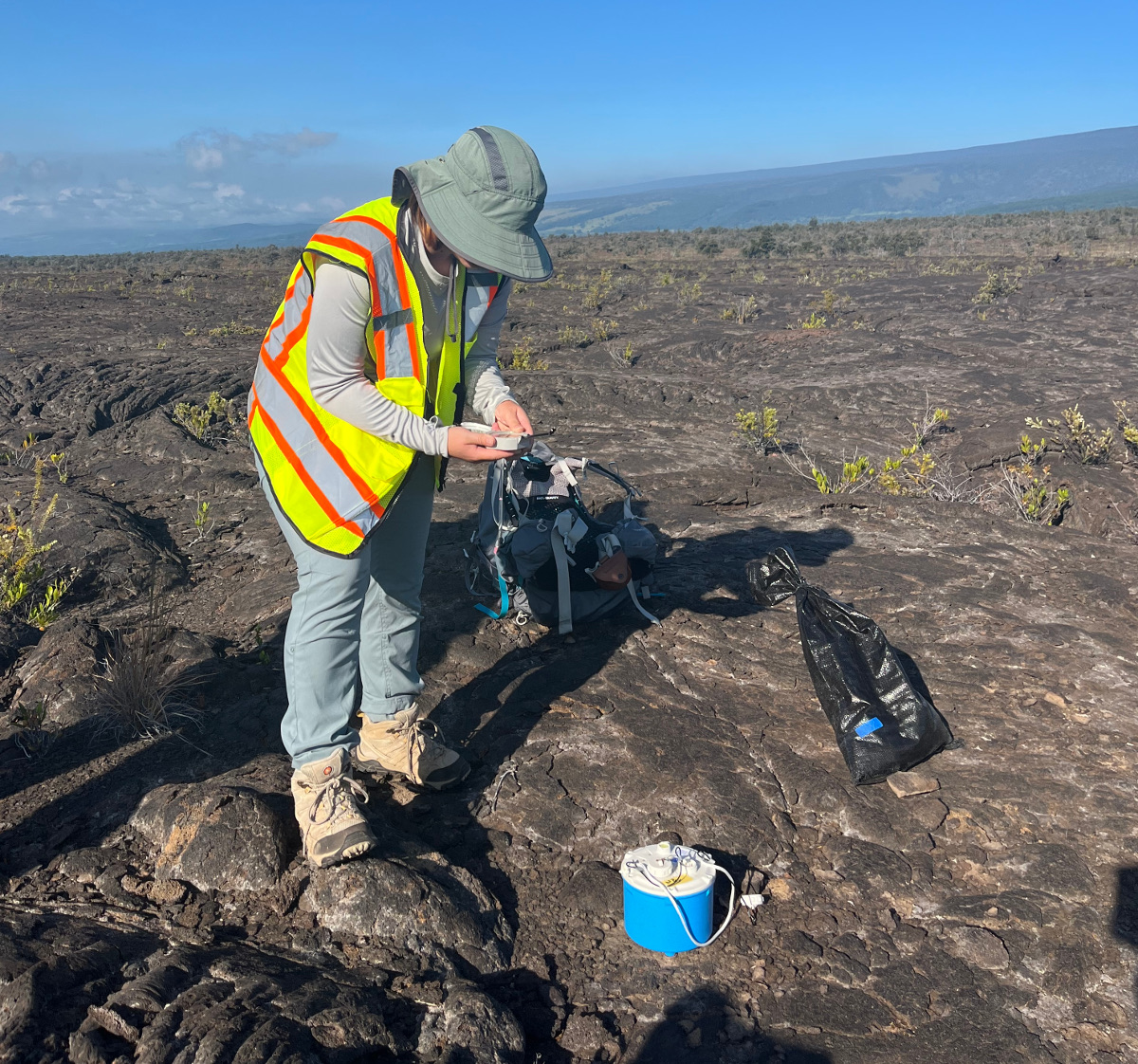Hawaii Volcanic Activity Continuous Live Feed

USGS: "Hawaiian Volcano Observatory staff and University of Hawai'i at Mānoa collaborators walk on lava flows from 1823 along the Hawai'i Volcanoes National Park boundary fence as they hike to collect seismic nodes that have been deployed in Kīlauea's Southwest Rift Zone for the past two months. With permission from the National Park and landowners, the nodes were deployed as part of a project funded by the Additional Supplemental Appropriations for Disaster Relief Act of 2019 (H.R. 2157) in an effort to better understand the deep earthquake activity beneath the Pāhala region. On the far side of the fence, the "Great Crack" is visible; this feature parallels Kīlauea's Southwest Rift Zone and in 1823, lava erupted from the lower 6 miles (10 km) of the crack." (USGS image by K. Mulliken.)
- The current Volcano Alert Level for Kilauea remains at WATCH, with an Aviation Color Code of ORANGE. All recent eruptive activity has been confined to Halemaʻumaʻu crater at the summit within Hawaiʻi Volcanoes National Park. No significant changes have been observed at the summit or in either rift zone.
- A photo showing intermittent spattering on the northeast rim of the Kīlauea summit lava lake was recently published by the USGS Hawaiian Volcano Observatory.
- Another USGS photo shows seismic nodes being collected along the Kīlauea Southwest Rift Zone. The nodes were deployed in an effort to better understand the deep earthquake activity beneath the Pāhala region.
From the USGS HVO update posted on Friday:
Halemaʻumaʻu Lava Lake Observations: Eruption of lava from the western vent into the active lava lake and onto the crater floor continued over the past 24 hours. The active part of the lava lake showed continuous surface activity. Overflight measurements from August 16, 2022, indicated that the crater floor had seen a total rise of about 137 meters (449 feet), and that 104 million cubic meters (27.5 billion gallons) of lava had been effused since the beginning of this eruption on September 29, 2021.
Summit Observations: Summit tiltmeters recorded relatively little ground deformation over the past 24 hours. Volcanic tremor remains above background levels. A sulfur dioxide (SO2) emission rate of approximately 2,000 tonnes per day (t/d) was measured on September 6, 2022.

A University of Hawai'i at Mānoa graduate student uses a compass to check the orientation of a seismic node (blue) that was deployed on Kīlauea's Southwest Rift Zone over the past two months. Seismic nodes are small and light seismometers that measure ground shaking at the location where they are placed. HVO scientists will use the data collected by the network of over 80 seismic nodes to create images of the structure of the Earth beneath Pāhala from as great as 40–50 km (25–31 miles) below sea level all the way to the surface. (USGS image by K. Mulliken, cropped for display)
Rift Zone Observations: No unusual activity has been noted along the East Rift Zone or Southwest Rift Zone; low rates of ground deformation and seismicity continue along both. Measurements from continuous gas monitoring stations downwind of Puʻuʻōʻō in the middle East Rift Zone remain below detection limits for SO2, indicating that SO2 emissions from Puʻuʻōʻō are negligible.
Hazard Analysis: This eruption at Kīlauea's summit is occurring within a closed area of Hawaiʻi Volcanoes National Park. High levels of volcanic gas are the primary hazard of concern, as this hazard can have far-reaching effects downwind. Large amounts of volcanic gas—primarily water vapor (H2O), carbon dioxide (CO2), and sulfur dioxide (SO2)—are continuously released during eruptions of Kīlauea Volcano. As SO2 is released from the summit, it reacts in the atmosphere to create the visible haze known as vog (volcanic smog) that has been observed downwind of Kīlauea. Vog creates the potential for airborne health hazards to residents and visitors, damages agricultural crops and other plants, and affects livestock.

Source: https://www.bigislandvideonews.com/2022/09/09/kilauea-volcano-eruption-update-september-9/
0 Response to "Hawaii Volcanic Activity Continuous Live Feed"
Post a Comment